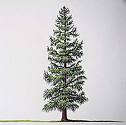Larix Laricina Tree Information
Images of Larix Laricina:






Larix Laricina grows in the following 26 states and provinces:
Alaska, Alberta, British Columbia, Connecticut, Illinois, Indiana, Maine, Manitoba, Maryland, Massachusetts, Michigan, Minnesota, New Brunswick, New Hampshire, New Jersey, New York, Nova Scotia, Ohio, Ontario, Pennsylvania, Prince Edward Island, Saskatchewan, Vermont, West Virginia, Wisconsin, YukonInformation about Larix Laricina:
The Larix Laricina is commonly known as the Alaskan Larch, American Larch, Eastern Larch, Hackmatack, Tamarack as well as Tamarack Larch.
The currently accepted scientific name of tamarack is Larix laricina (Du Roi) K. Koch . The genus Larix consists of 10 species of deciduous, coniferous trees found in cool, temperate regions of the northern hemisphere. Three species of Larix, including tamarack, are native to North America. Tamarack is a widely distributed species that exhibits considerable genetic variation. At one time, plants from Alaska were considered as either a distinct species or as a variety of tamarack. Recent research shows that although Alaskan plants exhibit some variation in cone and needle characteristics, the variation is insufficient to warrant recognition as a separate species or variety . Across tamarack's range the pattern of variation is gradual, and no varieties or ecotypes are currently recognized . Natural hybridization between tamarack and other larches has not been documented. Tamarack has been artifically crossed with Japanese larch (L. leptolepis) and European larch (L. decidua) . Tamarack is distributed across most of northern North America. It occurs from Newfoundland and Labrador northwest across northern Canada to the northern Yukon Territory, south to northeastern British Columbia and central Alberta, southeast to southern Minnesota, Wisconsin, and northeastern Illinois, and east to New England . A major disjunct population occurs in the interior of Alaska between the Brooks Range to the north and Alaska Range to the south . It also occurs locally in the mountains of West Virginia and western Maryland.In northern Minnesota and throughout much of Canada, tamarack forms extensive pure stands. Throughout the rest of its range in the United States it forms isolated pure stands or is a minor component of other forest types . In the northeastern United States, tamarack is characteristically found in open and forested bogs, but it seldom dominates in forested bog communities . Throughout its range, black spruce (Picea mariana) is usually associated with tamarack. In Alaska, black spruce and tamarack may codominate wet, lowland sites with shallow permafrost . Tamarack is sometimes a dominant tree in seral lowland communities. It has been listed as a community type (cts) dominant in the following classifications: Area Classification Authority AK general veg. cts Viereck & Dyrness 1980 AB general veg. cts Moss 1955 PQ: ST. Lawrence general veg. pas, cts Dansereau 1959 Valley Some of the information provided here is attributed to:Uchytil, Ronald J. 1991. Larix laricina. In: Fire Effects Information System, [Online]. U.S. Department of Agriculture, Forest Service, Rocky Mountain Research Station, Fire Sciences Laboratory (Producer). , available at the USDA Fire Effects Information System (FEIS) website